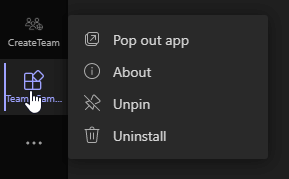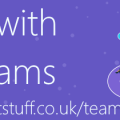You can now pop-out apps and tabs into their own window in Microsoft Teams
This was announced last week but I’ve only just got around to writing about it. I wasn’t going to write anything at all, but the more I thought about it the more I realised I had some mixed views about this.
It’s now possible to “pop-out” Teams applications into their own window, which can then be resized or moved onto another monitor. There are two ways to do this:
- for apps that are on the left-rail or within the apps ellipsis menu, right-click the app and choose “Pop out app”
- within an app, an individual tab can be popped-out, look for the icon in the top-right corner

You can pop-out any application apart from the “core” Teams functionality such as Activity, Chat, Teams, Calendar, Calls and Files.
There’s nothing extra developers have to do in order to enable this (but also seemingly no way to prevent it from happening). Because tabbed applications are really just iFramed webpages behind the scenes though, there shouldn’t really be any change in how those application function.
You can pop-open each application from the rail once, but can have multiple applications opened. Also, you can pop-open each tab within an application once, including applications you have already popped open. This means that (including the application that opens in Teams) you can have 3 versions of a tabbed webpage open: in-Teams, popped-open from the rail, and popped-open from the tab page. In fact, because you can pop-open each tabbed page once and then navigate between tabs you could potentially open more copies of a tab page, up to N+2 where N is the number of tabs in your application. They all function independently of each other.
As far as I can tell, there’s no way to maintain the popped-out applications once you quit Teams, they don’t re-appear on re-load.
Good Thing, Bad Thing?
I’m a little bit conflicted by this. On the one hand, it’s good to give users choices, and for people with larger/multiple monitors who spend a lot of time in one or more apps this will be a productivity win by enabling them to keep a specific application open alongside other information in Teams.
On the other hand, I can’t help thinking that this goes against the whole point of adding applications to Teams, which is that information and action is displayed to the user in the context of conversations and communication they are having. If the app is so large or so much the focus of a user’s activity that it needs to be opened and displayed completely separately from Teams then it’s not really a Teams app, it’s a stand-alone app which is using Teams as a launcher shortcut. Is Teams really the right place for apps like that?
I’m really interested to see if this will evolve further. It might be that in Teams apps, Microsoft has created a packaging and manifest technology which can be exported outside of Teams. For instance, what if these applications could be “exported” to Windows and given their own taskbar icon or desktop shortcut? Same manifest, same application, same update process, just processed by Windows rather than Teams. All of the IT Admin controls for allowed or denied applications and policies are already in place and this would provide a powerful yet simple way to manage desktop applications (well, at least those desktop applications which can be rendered as web pages inside an iFrame). To be clear I don’t think Microsoft has any particular plans to do this but it would be an interesting evolution of Teams apps for sure.







It is true that Teams is getting overloaded with Apps and Tabs and acting as a mere launch pad. That said, not only are Teams App iframed if you switch focus away from the tab web app to go even to the chat tab of the same app, or to another chat or channel, the entire web app has to reload on return. If you have an unfinished form on that page (that you may be using in conjunction with chat that is going on) you will lose state unless you code around this. All polling activity may also suspend when tab is not in focus. Also on return to app, you have to additionally click on the web tab again to return (2 clicks to return in the normal case). So the pop out here may provide a way to leave the web tab open and easy to navigate to.
Useful in contact center apps.